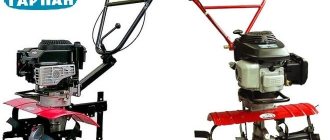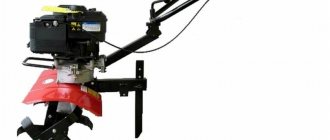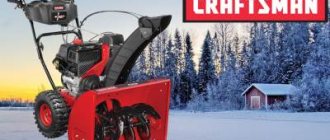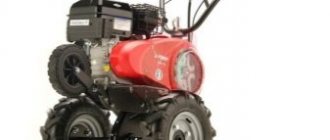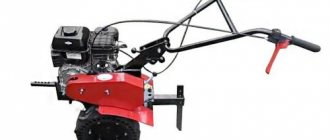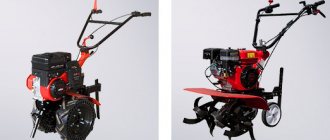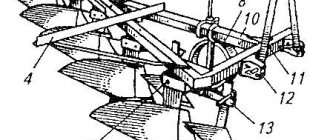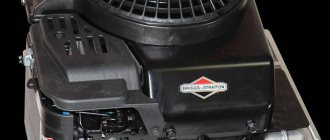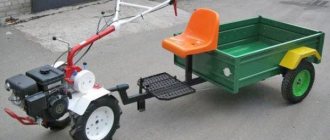There are not many models of motor cultivators produced on the Russian market. Therefore, after appearing motor cultivator Tarpan-03 Many people turned their attention to him. This is a fairly powerful and versatile tool that can be used without problems anywhere in the vast homeland. And the point is not only that the device can withstand various climatic conditions, but also in the peculiarities of its characteristics.
Appearance of the Tarpan-03 motor cultivator
Advantages and disadvantages of Tarpan brand cultivators
Since Tarpan motor cultivators are assembled at an enterprise belonging to the defense industry, the plant’s products are distinguished by high quality and reliable assembly.
The first models began to be assembled in the early 90s, when the production crisis forced the company to look for alternative directions of development. Lack of experience left its mark on the first cultivators - they could not compete with the products of foreign manufacturers. However, after introducing new technologies and concluding contracts with leading manufacturers of engines for agricultural machinery, Tulamashzavod was able to assemble equipment that meets the most stringent technical requirements and standards. The competitive advantages of modern Tarpan motor cultivators include:
- Reliable, durable motors from leading industry manufacturers;
- High build quality, technical performance;
- Adaptation to domestic operating conditions;
- Low maintenance, high maintainability;
- A wide selection of attachments allows you to expand the range of work performed.
The disadvantages of the devices include a fairly small number of service centers and company representative offices, which creates certain difficulties in the process of servicing and repairing equipment. However, this drawback is compensated by the simplicity of the design - if necessary, following the instructions in the user manual, the owner of the cultivator will be able to independently eliminate most of the malfunctions.
Attachments for working with a cultivator
Good power and reliable spare parts allow the use of a wide range of attachments. According to the operating instructions, the following can be used with the cultivator:
- Weeder for weed control between rows. The distance between rows should not be less than 30 cm;
- Hiller - helps to make furrows, mark out areas for beds, and care for potatoes;
- Lugs - make the cultivator heavier and improve its adhesion to the ground;
- Special wheels with a frame make moving the cultivator more convenient;
- Plow - used for deeper soil cultivation.
By purchasing some devices from this inventory, the owner of the cultivator will make planting and caring for the beds much easier, and will save a lot of time and effort.
Fuel supply pump repair
The engine for a cultivator plays the most important role in the design of the unit. Often it does not start due to a faulty fuel pump.
The pump serves to supply the fuel mixture to the carburetor at a certain point in the cycle. If fuel is not supplied, then the engine will not start. The pump is faulty in the following cases:
- If there is a disruption in the fuel supply to the engine injectors;
- In case of fuel leakage due to mechanical wear;
- The appearance of strange noises during operation.
To eliminate damage, you should disassemble the pump and inspect it. It is quite possible that the engine of the cultivator will not start due to contamination inside the pump. In this case, the device will need to be cleaned and replaced.
This cultivator model is designed for cultivating a plot of land that has an area of no more than fifteen acres. The Tarpan cultivator was developed more than 25 years ago. At the same time, work to improve the design by the plant did not stop throughout this time.
Fuel consumption by motor cultivator depending on loads
Despite the not very high power of the unit and its modifications, it consumes a significant amount of fuel.
In the process of plowing the soil, the model requires approximately 1.5 liters/hour. This figure may vary depending on the task being performed. Thus, when cultivating hard soils with a plow, the cultivator consumes at least 1.8 liters per hour of operation. When clearing snow, it “eats” at least 2 liters. fuel. However, it is important to take into account that a certain amount of fuel is lost even when the engine warms up.
When hilling potatoes, the cultivator requires, on average, 1.6 liters. fuel, and when working with a rake - about 1.5 l./h. work.
About oil change
After the first five hours of operation, most customers change the oil. This information is easy to find in reviews. Otherwise, the motor may jam due to debris that ends up inside the motor. It is best to leave it hot while work is being done.
The waste is drained into a separate container when the engine has been warmed up to a suitable temperature. The equipment is left in one position until the liquid is completely drained. After that the plug is tightened and new oil is poured in.
The best option is compounds that are originally intended for four-stroke engines. High-quality materials reduce friction between individual parts. The engine life is increased and it receives protection against corrosion.
Don't forget about changing the oil
Repair and maintenance of Tarpan walk-behind tractor
When operating a walk-behind tractor, the farmer must perform periodic maintenance of the unit.
It is as follows:
- After the first start of the machine, it is necessary to change the oil in the gearbox.
- Every day:
- cleaning and wiping the walk-behind tractor;
- checking for oil and fuel fluid leaks in all connections;
- control of fasteners, tightening of bolts and nuts;
- checking the oil level in the gearbox;
- checking, cleaning, repairing the clutch.
- Every 100 hours or once a year:
- changing the oil in the gearbox;
- Lubrication of rods and controls.
If a malfunction occurs in one of the components or connections, it is necessary to repair or completely replace it. Spare parts and components for Tarpan can be purchased from brand dealers or on free sale in domestic markets.
Various parts and materials can be subject to rapid wear and consumption, including:
- drive belts;
- oil seals;
- rings;
- bushings;
- filters.
During the warranty period, repairs by yourself are prohibited; they must only be carried out by the manufacturer.
The instructions for using the Tarpan unit provide all the necessary knowledge on working with a motor cultivator.
If additional attachments are attached to the unit, certain operator skills are required. For this purpose, the manufacturer has developed special rules and operating instructions for mounted mechanisms. These technical documents are supplied complete with the walk-behind tractor.
Which engines do you prefer: Japanese or American?
Classification of oil grades
To increase the service life of a gasoline or diesel engine, you need to make the right choice of engine oil. Failure to replace it in a timely manner reduces the service life of the engine. How to choose it, in what quantity, how to pour it into the walk-behind tractor - we’ll talk about this in more detail. Each mini-tractor or walk-behind tractor includes instructions and a product data sheet. In the instructions, the manufacturer lists suitable types of fuel and lubricants that can extend the life of the equipment. Engine oil performs the following functions:
- cooling;
- lubricants;
- seals;
- cleaning.
During air cooling, the lubricant settles on the walls of the hot cylinder. These deposits contaminate engine parts and complicate lubrication processes. Therefore, the lubricant contains antioxidant additives. They clean the cylinder walls from carbon deposits and extend the service life of the walk-behind tractor. Different climate zones require the use of different oily liquids. They differ in viscosity, composition and purpose.
By viscosity
Viscosity is determined according to SAE J300 standard. For mechanisms it depends on the following characteristics:
- unit design;
- features of work;
- age of the mechanism;
- ambient air temperature.
Scientists have developed all-season compositions that are used for pouring into walk-behind tractors in summer and winter. Their designations are 5W-40, 10W30.
By composition
In addition to seasonal characteristics, lubricants are divided into types based on composition:
- mineral;
- synthetic;
- semi-synthetic.
An air-cooled engine heats up quickly during operation. Motor oil reduces its temperature. The wrong category causes a breakdown in the motor. It is not recommended to use synthetic oil in mixture with mineral oil.
By purpose
Lifan products require summer grade SAE-30, and SAE 10W-30 for winter conditions. There are no conditions for quality category. Motoblocks of the Kaluga Engine company are filled with an all-season composition 10W-30 or 15W-30 of SF or SH quality.
User manual
The purchased cultivator must be assembled in accordance with the recommendations set out in the documentation. It is recommended to check the tightness of threaded connections and the oil level in the gearbox and engine crankcases.
The deepening of soil milling machines is carried out by applying force to the handles. The installed plowing depth regulator also goes into the ground and creates additional movement resistance, adjusting the speed of movement. If the cutters begin to dig into the ground, and the speed drops to zero, then it is necessary to reduce the depth of the tool into the soil. To rotate, the cultivator tilts left or right using the handles.
The documentation provides a list of routine maintenance; the intervals depend on the type of motor installed. For example, the initial oil change in the engine is performed after the unit has been run-in, the duration of which depends on the modification of the engine. During operation, it is recommended to check the oil level; some engines are equipped with an emergency ignition switch, which is activated when the fluid volume decreases.
Malfunctions and their elimination
If it is difficult to start a gasoline engine or there are interruptions in operation, you should check the operation of the carburetor and the standard speed controller. To carry out repairs yourself, you need to adjust the regulator in accordance with the manufacturer's recommendations and check the presence of fuel in the tank. Additionally, the condition of the connecting line and the valve is monitored, and then the gap between the spark plug contacts is checked.
Overheating of the power unit indicates that the cultivator is overloaded or the air filter and fins are clogged with dirt. To restore performance, you should reduce the loosening depth or change the filter. If the problem persists, then inspection and cleaning of the external part of the engine from accumulated dirt is required. A common defect, according to reviews from owners, is oil leakage through the junction line of the gearbox housing halves. The defect occurs due to a crack or wear of the gasket or seals. Repair consists of purchasing and installing new parts.
Vibration during operation indicates stones getting between the cutter teeth or damage to the tool. It is necessary to stop the engine, inspect the cultivator and replace worn parts. Additionally, it is recommended to check the tightness of the bolts securing the engine.
Device
The Tarpan motor-cultivator is based on a welded structure to which the crankcase of a gasoline or electric engine is attached. The internal combustion engine transmits torque to the chain gearbox using a manually operated belt clutch. Some modifications use a two-stage gearbox with additional speed for moving backwards. On electric cultivators and simplified models with a gasoline engine, a worm gearbox with an automatic centrifugal clutch is used.
The equipment plows the soil with metal cutters located on axle shafts. A metal stop is installed under the control handles to regulate the depth of soil cultivation. Instead of cutters, it is allowed to install metal wheels or rollers with rubber pneumatic tires. To store the fuel supply, a steel tank located on the top of the engine is used. The design of the equipment provides for the installation of protective shields that reflect clods of soil and stones flying from under the cutter.
Attachments
The company offers a wide range of attachments for cultivators:
- metal lattice wheels designed for movement on soft ground;
- device for towing additional trailers;
- milling cutter with working elements of the “crow’s feet” type;
- attachment for automatic weeding (installed instead of a milling cutter);
- protective discs that prevent damage to plants by rotating tools;
- plow with a fixed share position;
- rotary mower of the Zarya type, driven by the engine crankshaft;
- frontal blade for snow removal;
- hiller plow.
Service Features and Operating Instructions
Let's take as a basis the operating rules from the instructions for ≪TMZ-MK 03≫.
Changing the oil in the gearbox
Draining the oil immediately after work makes the procedure easier.
We use oil TAD-17I GOST 23652-79. Replacement with transmission oils of class SAE 90, SAE 75W/90, API categories GL-4, GL-5 with a volume of 0.35 liters is acceptable.
Motor cultivator ≪Tarpan MK-03-02 WM168FB≫
- We change the oil in the gearbox after the first 5 hours of operation of the cultivator.
- Every 5 hours or daily we check the tightness of the connections of engine parts for oil and fuel leaks.
- Every 100 hours or annually we change the oil in the gearbox.
- To check the oil level in the gearbox, it must be drained into a measuring cup and added to a volume of 0.35 liters.
- Oil is drained and refilled into the gearbox through the same hole, which is closed with a plug.
Replacing oil seals
During the warranty period, to repair the breakdown, contact the service center or the manufacturer.
After the warranty period, the service center will replace the oil seal without any problems. But you can do it yourself.
Replacement of the oil seal is necessary in case of oil leakage from the gearbox.
The cultivator is run in during the first 12 hours.
To replace the oil seal yourself:
- clean the gearbox and drain the oil;
- turn the gearbox upside down with the bolts and open the housing;
- Mark with a marker the position of the shaft with gears in relation to the body so that after repair the shaft fits correctly;
- remove the oil seal with the cover from the shaft;
- carefully remove the oil seal, which sits tightly in the cover, with a blunt screwdriver or similar tool, without damaging the cover;
- Place the new oil seal on the cover so that it is in place, place the old one on top of it and tap it with a hammer.
The new one should snap into place until it stops. If a gap remains, this needs to be corrected.
Replace the second oil seal in the same way. Then, lubricate the gearbox halves with sealant and connect them taking into account the marks made earlier with a marker.
Running in and launching the cultivator "Tarpan"
In the first 12 hours there is a break-in. Do not use the unit at full capacity during this period. It is better to go through one section several times.
Initially, the clutch lever is free, the gear shift knob is in the neutral position.
The oil level must be checked before starting the cultivator.
To start the engine:
- move the gas control lever to the 1/4 stroke position;
- Pull the cord handle slowly until you feel resistance;
- quickly pull the cable to start the engine and release it slowly, without jerking.
If it doesn't work, try again.
Stopping the engine
To turn off the engine, release the control lever. It will return to the idle position under the action of the return spring. Press the lever all the way and the engine will stop.
Service Features and Operating Instructions
The instruction manual is the main document of the cultivator, which contains a description of the design, as well as rules for operation, maintenance, storage and transportation. Compliance with the rules will help the owner increase the service life of the equipment and ensure safe working conditions.
First launch and run-in
After assembly, the new cultivator undergoes a conservation procedure necessary to protect the mechanisms from corrosion. Before the first start, the owner must unscrew the spark plug, wash it with gasoline, and also rotate the crankshaft 10-15 revolutions to remove preservative lubricant.
In most cases, engines are supplied without engine oil. It should be remembered that malfunctions caused by dry operation of the motor are not covered by warranty. The oil must be selected based on the ambient temperature and the recommendations of the engine manufacturer.
During the first 12 hours of operation, the cultivator is run in - the friction pairs of all moving units are run in. During the break-in process, it is not recommended to use the cultivator at full power.
Upon completion of the break-in, it is necessary to replace the engine oil, which contains chips and other by-products of running in the cultivator components.
Changing the oil in the gearbox
According to the requirements of the operating manual, after the first 5 hours of operation it is necessary to change the oil in the gearbox. When selecting a lubricant, you must follow the requirements of the operating manual.
Most gearbox models are designed for oils with API GL-4 or GL-5 approval. Using the wrong lubricant, for example TAD-17 or NIGROL, can quickly damage the gearbox.
Replacing oil seals
During operation, under the influence of external factors, mechanical damage to the gearbox seals may occur, which leads to oil leaks from the mechanism. If the cultivator is still under warranty, we recommend contacting your nearest service center. An alternative option is to replace the seals yourself.
Before performing work, it is necessary to drain the oil from the gearbox. You should also note the spatial position of the shaft relative to the housing to eliminate the possibility of incorrect assembly.
Possible faults
| Malfunction | Probable Causes |
| Difficulty starting the engine | · The speed controller settings are lost; · Fuel supply to the carburetor is interrupted; · Malfunction of the ignition system; · Carburetor clogged. |
| The engine gets very hot | · The air filter is clogged; · The cooling system is clogged. |
| The engine cannot reach maximum speed | · The air filter is clogged; |
| Motor output shaft does not rotate | · The engine runs at low speed; · Centrifugal clutch does not work. |
| The engine output shaft rotates at idle speed | · Clutch springs are stretched or damaged; · The engine speed controller control is incorrectly configured. |
| Oil is leaking from the gearbox | · Reducer seals are damaged; · Crack in the gearbox housing. |
If you do not have experience in repairing or servicing cultivators, we do not recommend troubleshooting them yourself. Unqualified intervention can aggravate the situation.
Basic faults
Let's look at typical motor cultivator malfunctions, their causes and solutions.
- The cultivator engine stalls or does not start.
- The motor is heating up.
- High oil consumption.
There may be several reasons why the engine does not start:
- The engine speed settings are off.
- Fuel hoses do not supply fuel to carburetor.
Resuscitation work:
- check the presence and quantity of fuel in the tank, top it up if necessary;
- We inspect the spark plug; if it is faulty, we replace it;
- if the candle is working, but there is carbon deposits, remove it;
- check and, if necessary, adjust the spark plug gap.
- We inspect the fuel supply hoses to the carburetor; if there is a breakthrough, we replace them.
The engine gets hot because:
- The cooling system is not working correctly.
- The air filter is clogged and requires replacement (rarely cleaning).
Model range overview
Tarpan motor cultivators compare favorably with other similar models due to their unique prefabricated design - the agricultural machine can be conveniently transported to the work site in disassembled form: power unit + gear component.
Modern cultivators are equipped with Honda and Briggs&Stratton engines - reliable, economical, requiring minimal resources for operation. The Tarpan family of motor cultivators also includes models with Chinese Zongshen and Loncin engines, which allows us to produce competitive equipment at budget prices.
The first Tarpan-01 appeared in 1993. The car was equipped with a two-stroke engine with a power of 6.2 hp. Despite various design flaws, it was quite popular. A few years later, a new modification, Tarpan-03, was developed, which is still in demand today.
Tarpan TMZ-MK-03
The unit is equipped with an American 6 hp motor. with a motor life of 1000 hours. Thanks to the worm gearbox, 1 speed is provided. The cultivator is designed to perform agricultural work on all types of soil. The cutters provide processing of strips with a working width of 35-100 cm.
Cultivator Tarpan TMZ-MK-03
Thanks to its low weight of 45 kg, the machine is very maneuverable. The ergonomic steering wheel can be adjusted to the height of the operator and the length of the handles; it is possible to control the cultivator from the side without trampling the newly plowed area.
Specifications
| Weight, kg | 45 |
| Dimensions (LxWxH), mm | 1300x700x1060 |
| Warranty, months | 36 |
| Cultivation width, cm | 30-70 |
| Engine | Briggs&Stratton I/C 6.0 |
| Oil volume in the gearbox, l | 0,6 |
| Cultivation depth, cm | 20 |
| Number of gears | 1/0 |
| Gearbox | single stage, worm |
| Drive unit | gear |
| Clutch type | dry, automatic, centrifugal |
| Rotation speed of cutters, rpm. | 120 |
| Type | Briggs&Stratton I/C 6.0 with vertical shaft |
| Fuel | petrol |
| Engine displacement, cm3 | 190 |
| Cooling | active air |
| Fuel tank, l | 3,8 |
| Power, hp | 6 |
| Starting system | manual |
Motor cultivator Tarpan TMZ-MK-031
The cultivator belongs to the light group - its power is 3.5 hp, its weight is only 28 kg, the tillage width is 50 cm to a shallow depth of 14 cm. This modification is convenient when working on small plots of land, in greenhouses, and gardens. The unit is characterized by good maneuverability and is very convenient to use due to its low weight.
Motor cultivator Tarpan TMZ-MK-031
Specifications
| Milling cutter rotation direction | direct |
| Number of cutters included | 4 things. |
| Tillage width | 50 cm |
| Cultivation depth | 14 cm |
| Milling cutter diameter | 240 cm |
| Engine power | 3.50 hp |
| engine's type | petrol, four-stroke, cylinders: 1 |
| Gearbox type | worm |
| Number of gears | 1 forward |
| Gearbox type | single stage |
| Clutch type | belt |
| Weight | 28 kg |
| Dimensions, LxWxH | 1210x510x1020 mm |
Let's demonstrate the high functionality of this small but quite productive unit in a video review:
Cultivator Tarpan TMZ-MK-04
Lightweight, compact unit with 6.05 hp Briggs&Stratton engine. designed for processing medium-sized plots of land. Very easy to operate.
Cultivator Tarpan TMZ-MK-04
Specifications
| Class | easy |
| Type | cultivator |
| Tillage width | 56 cm |
| Number of cutters included | 4 things. |
| Milling cutter rotation direction | direct |
| Cultivation depth | 20 cm |
| Engine manufacturer and model | Briggs and Stratton 12/802 |
| engine's type | petrol, four-stroke, cylinders: 1 |
| Engine power | 4.45 kW / 6.05 hp |
| Engine capacity | 190 cc cm |
| Gearbox type | worm |
| Number of gears | 1 forward |
| Gearbox type | single stage |
This cultivator is equipped with a 2.2 kW electric motor. Despite its low power, it has sufficient weight to process large areas. The width of the cultivated land during cultivation is 35-70 cm, the depth is 20-30 cm. The agricultural machine can be rationally combined with various attachments, and the possibilities of use are limited only by the length of the electrical cord.
Engine Honda GCV-160
The Honda GCV-160 is a four-stroke petrol engine with overhead camshaft (OHC), vertical crankshaft, aluminum cylinder and air cooling. The valve location is overhead (OHV).
- Engine displacement – 160 cm3.
- Engine power – 4.1 kW (5.5 hp), at 3,600 rpm.
- Maximum torque – 11.4 N.m / 1.16 kgf/m, at 2,500 rpm.
- Cylinder diameter – 64 mm.
- Piston stroke – 50 mm.
- The oil volume in the crankcase is 0.55 l.
- Basic dry weight – 9.8 kg.
- Overall dimensions – 366 x 331 x 360 mm.
The Honda GCV-160 engine uses innovative technologies such as: the cylinder and combustion chamber are a single part, the timing belt is located in the engine crankcase. It is characterized by a low noise level during operation, a minimum number of mechanical parts that cause noise; low dead weight of the engine. The timing belt does not require maintenance or replacement during the entire service life of the engine.
In terms of efficiency, this engine demonstrates the lowest fuel consumption of all engines in this category. GCV series engines are equipped with a special lubrication system (a drive belt that provides additional lubrication with machine oil) and a fuel pump, so engines in this series can operate at an angle of 45° (with the cylinder head on top).
Popular unit modifications
The most popular configurations are Tarpan TMZ-MK 03 and Tarpan TMZ-MK 04.
Motor cultivator Tarpan TMZ-MK 03
Specifications:
- Engine manufacturer – petrol 4-stroke Briggs&Stratton;
- Engine power – 6.0 hp;
- Clutch – dry, automatic, centrifugal;
- Gearbox – single-speed, worm in an oil bath;
- Working width – 350, 700, 1000 mm;
- Overall dimensions (control handles folded) – 1300x700x1060 mm;
- Weight – 45 kg;
- Number of cutters included: 4 pcs.
- Milling cutter rotation direction: straight
- Cultivation depth: 20 cm
- Engine power: 4.45 kW / 6.05 hp
- Engine capacity: 190 cc cm
Characteristics
All cultivators offered by the company are equipped with standardized control handles mounted on a fixed steering column. The handles are adjustable in angle of inclination; during transportation, the parts are folded, reducing the dimensions of the equipment. On the handles there are controls connected to the actuators by steel cables passed through the shells. Cable drives are equipped with special adjusting couplings.
The width of the processed strip is 350-1100 mm, depending on the power and modification of the cultivator. Motors can be removed for installation on a four-wheel lawn mower, which is purchased separately. This design expands the scope of application of agricultural equipment and makes it easier to care for lawns in front of country houses.
